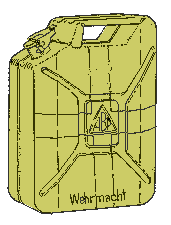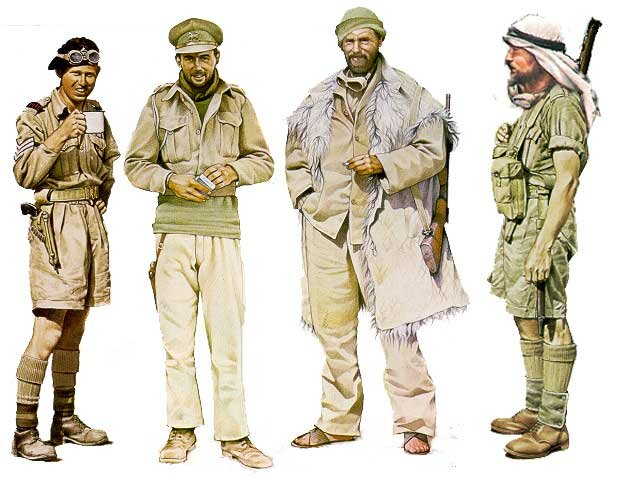This page is dedicated to the uniform and equipment of the LRDG. It is divided in two section:
Patrol Equipment
Trucks
There is a fuller treatment of the trucks used by the LRDG in a separate section. All of the trucks used by the LRDG possessed specialty equipment used in the conduct of their missions. Such items as sun compasses and sand channels are described below.
In General:
Initially the vehicles were modified civilian vehicles, later they were CMP or Canadian Military pattern vehicles and the ever popular Willys MB Jeep. Depending on the mission of the Patrol vehicles, they had a weight rating of either 15 CWT or 30 CWT. CWT is an archaic British payload weight term for 100 pounds. So a 15 CWT vehicles is capable of towing 1,500 pounds or a 3/4 ton vehicle.
Drive Train:
For the most part, the LRDG preferred 4X2 vehicles. This means the vehicle had four wheels but only had power going to two of the wheels. A 4x4, such as a Jeep, means the vehicle has four wheels and power can go to all four wheels. The reason the LRDG preferred the two wheel drive trucks is because they tended to have less weight up front and the lighter front seemed to lessen the chances of getting stuck in the loose sand. The fully loaded LRDG truck put a lot of extra weight on the rear axle which provided the truck with plenty of traction.
Painting (Camouflage)
While most photographs make it difficult to tell how the trucks were painted, personal recollection seems to point that 8th Army Dark Yellow was far from the standard that most current modeling enthusiasts prefer today. In the sandy desert regions desert pink and a variety of pastel shades of light green, blue and, purple were also used. The reason these colors were used is they were effective in blending in with the heat and haze of the desert sand. in the more rocky regions of the desert, middle stone, slate blue, and grey were commonly used. There was no standard camouflage scheme used.
Markings
Each patrol carried markings unique to the patrol. For instance, T patrol, a New Zealand patrol had a small kiwi painted on the right front of the truck's bonnet. on the left front was a "Maori" nickname which began with the letter "T". R and W patrols had a similar policy with naming their vehicles. Y Patrol, on the other hand carried names of Musketeers on their Right front fender. According to Ian Chard who heard it from his father, a member of "Y" Patrol, this was a done more as a private joke between patrol members. Later the trucks took the names of Race Horses.
G Patrol was drawn from the Guards units. As such, their marking consisted of red and blue or black and red bars with lettering superimposed in white. G patrol did not name their vehicles, but the patrol commander flew a small flag from his vehicle when he was riding in it.
Color Chips
Below are a few sample colors used in painting the trucks:
(note, due to different computer settings, not all colors are going to appear the same from computer to computer.)

8th Army Desert Yellow

Desert Pink

Light (Azure) Blue

Light Green

Middle Stone

Purple Brown

Slate
Sun Compass
Sun Compasses were developed earlier in the 20th Century and used in aircraft and on ships. When an ordinary magnetic compass is placed next to a large metal mass it doesn't always point to magnetic north, this is a problem in ships and aircraft. There are various ways to compensate for this effect used in ships, but it was found that these methods were unsatisfactory when used in aircraft, and so the sun compass was developed. The compass is not magnetic at all, when you align it with the sun it points north, (the compass contains a clock which enable it to track the sun across the sky). There is an entire chapter on this device in "From Lodestone to Gyrocompass" by H Hitchens and W. May, published by Hutchinson.
Because there are few features to get bearings off of in the Desert, the LRDG pioneered the use of Sun Compasses for navigating the desert. One of the chief duties of the LRDG was to act as pathfinders for larger units. They also trained navigators from various units in the art of navigating the desert with a sun compass
(In fact British Soldiers often referred to being in the desert as "on the blue" a term comparing the desert to the ocean.)
The patrol's main link to the GHQ was the No. 11 Wireless Set, an unlikely candidate for long range communication.
Wireless Set No. 11 was a portable transceiver developed in 1938. It was a general purpose low power set. It was commonly employed a vehicle station (truck/AFV), ground station and occasionally animal pack station. It's frequency range was 4.2-7.5MHz. MO control. RF output 0.6-4.5W. R/T and CW. It's normal maximum range was only about 20 miles!
However, the LRDG were no ordinary men and used special antennas to boost the operational range of the wireless set. They used a six fit rod antenna or the end fed Wyndom Aerial slung between two 17 foot tall wooden poles, creating a long range directional antenna.
The patrols relied heavily on Morse Communications and as such their radio operators were drawn from New Zealand's Divisional Cavalry and the Royal Corps of Signals. Personnel had to have experience with either the Merchant Marines, or the Marconi Company Long Range Morse Procedure. Later the radio operators were selected from or trained by SOE's School for Clandistine Signal Work.
The wireless set was located on the right hand side of the Radio Vehicle behind the driver, in a special compartment cut into the side of the truck. (Earlier vehicles required the side of the truck's bed to be dropped in order to access the radio.)

View of entire No 11 wireless set
Sand Channels and Sand mats
All LRDG patrol vehicles were supplied with "Unsticking Gear". This gear included a variety of pioneer tools plus sand channels and sand mats.
The sand mats were long pads made of reinforced heavy canvas. One side of the sand mats were a sand in color (or painted to match the vehicles), the other side was a series of red and white stripes. This is because the sand mats doubled as air markers. In the event the LRDG needed an aerial resupply the sand mats would be laid out like a signal T for the approaching aircraft.
The sand channels were a section of PSP (Perforated Steel Planking). PSP was used extensively in World War II for the construction of airfields and roads.
The way these devices worked:
Once a vehicle was stuck the sand mats or channels would be placed in front of the stuck wheels that provided the traction. As the wheels spun the mats or channels would be fed under the wheels which would then displace the weight of the vehicle over a larger area and unstick the vehicle. It sound easy but in practice it was extremely labor intensive.
Aerial Identification
Roundels
Probably one of the most important items carried by the patrol was a wooden roundel. This roundel was used to assist with identification from the air. Working behind the lines meant that the patrols not only had to worry about the enemy but also friendly aircraft. For this reason a wooden disc was carried with British Roundel on one side, and Swastika in a white circle on the other.
These marking were typically painted on the hoods of vehicles so that aircraft could identify the occupants easily from the air. Once a truck spotted an aircraft they would quickly determine is it was an friendly or an Axis aircraft and then display the roundel on the bonnet of the truck From the air the marking would appear painted on. This was more deceiving than simply waving a flag. With the roundel displayed the patrol would then wave to the aircraft and hope for the best.
Despite the use of such devices, as well as flags and such, a patrol had a 50/50 chance of being strafed by just about any plane (friend or foe) that spotted them. The sue of the roundel might only buy them enough time to disperse and reduce the damage done once the ruse was discovered.
Flags were also carried by the patrols and used in a manner similar to the roundels above.
One possibility to aid in the confusion was to wave an Italian flag when approached by a German pilot, in hopes that the Pilot would be less familiar with Italian vehicles. In any case, due to the nature of the war in the Western Desert, Axis forces used a lot of captured British equipment and no patrol was ever safe from any approaching aircraft.
Fuel Cans

Jerry Cans
The German 20 liter petrol/water cans. The cans later copied by Americans and British, become the standard military issue 5 gallon fuel cans. Typically a white cross was painted on cans used for drinking water or occasionally the word "water" would just be written in black or white.

Petrol Can
Flimseys (Flimsys)
Imagine is you will, a paper thin metal cube designed to carry liquids and you have a Flimsy.
The typical flimsey held four imperial gallons (about five U.S. gallons) of liquid and it was the standard container used by the British military when hostilities broke out. They leaked, they were easily damaged, and they were prone to corrosion. On top of that, it was practically impossible to reuse them more than one or twice.
They could not be air-dropped. As a matter of fact they would probably split open if they were dropped only a few feet. They were not easy to carry due to the carrying handle and the bulky shape.
As mentioned, the most common size was four Imperial gallons but two and one gallon sizes also existed. The smaller size were not a square as the larger four gallon container but were just as prone to damage.
Spare Tires
Spare tires were a necessity in the desert and patrols could not have too many. The tyre size depended somewhat on the vehicle being used but in general they were 16 inch low pressure sand tires. This meant that the air would be removed from the tyre to lessen ground pressure in loose sand and then the tires would be reinflated once harder ground was found.
The heat of the desert as well as rocks and a bumpy ride led to continual tyre punctures. The tires used inner tubes as opposed to the more common tubeless tires of today. Still, to fix a flat required breaking down the tire and, patching or replacing the inner tube and then remounting the tyre. Imagine attempting to jack up a three ton truck in loose sand. It was not uncommon for a patrol to instead brace the truck so it wouldn't sink and then dig a hole under the bad tyre and rather than attempt to jack up a vehicle.
The combination of heat and grinding surface of the sand reduce the life of tires dramatically. This led to blow outs which would create holes in the tires and inner tubes that were too big to patch. In this even a new tire would and inner tube would replace the old one. The crews carried both tires on rims and loose replacement tires. Often, spares would be covered with heavy paper or cloth to keep them out of the direct rays of the sun and to aid in camouflaging the large black circles.
Individual Uniform and Equipment
The LRDG was drawn from throughout the British and Common Wealth forces with every man arriving at the unit with their own personal equipment. As such, their was a variety of uniforms and personal equipment found within the unit. The tab, like the Scorpion crest, was not worn on patrol. Read more information about LRDG Uniform on our site.
LRDG Special Issue
When joining the LRDG each trooper was issued the following equipment:
- Arab Head-dress: While the traditional Arab head-dress consist of three parts: Thagiyah a tight fitting white skullcap, the flowing white head covering called Gutrah, and a black chorded band called an Ogal, the LRDG issued a sand colored Gutrah and the black Ogal. It is unclear if the Thagiyah was issued. Most sources say the LRDG placed a folded cloth between the scalp and the Gutrah to create an air pocket. This may have been the Thagiyah.)
- Motorcyclist/Tankers Goggles (not the disposable Rommel goggles)
- Sunglasses
- Tropical coat (a heavy kapok lined overcoat)
- Chapplies (Desert sandals)
Khaki Drill
The basic uniform worn in the Desert was the Khaki Drill uniform consisting of Khaki shorts and a khaki long sleeve shirt. The sleeves were typically rolled up.
The LRDG had a black "tab" worn on the epaulette of the shirt with the letters LRDG in red.

The Canteen
The Standard British Canteen held one quart of water. A larger two quart canteen was also used. The canteen was a vintage design changing little from the World War I canteen. It consisted of a enamel lined metal flask wrapped in cloth. The neck of the flask was painted blue to let you know it was for water. The flask was closed with a cork stopper.
The canteen did not come with a cap as did the German and American canteens, which explains why so many soldiers carried an enamel coated metal cup.
The cloth covering could be soaked in water to help keep the flask cool, but in the desert this was a waste of water and impractical because the water would evaporate so quickly. Typically the canteens were buried under the sand when on road watch which provided a better cooling solution.
Open Top Holster The open top holster was designed for the Royal Tank Regiment. It was made of heavy webbing, typically dark yellow in color for the desert campaign. Initially the holster hung from a 1937 web belt via a long wide strap and was secured to the thigh with two other straps. The idea was to place the holster lower on the hip and make it easier to reach when sitting in a tank. The strap was not very popular and eventually open top holsters with shorter straps were introduced. However, both versions served throughout the war.
A lanyard was typically attached to the British side arm and this went around the neck, also adding some difficulty to wearing the revolver low on the hip.
Of note are the six bullets secured on the outside of the holster. This also proved impractical. It exposed the bullets to the weather and it was also virtually impossible to pry the bullets from the web loops. If the trooper used a .455 Webley instead of the .380 Enfield the bullets would not fit. The cleaning rod is also stored on the outside of the holster.
Non-standard issue holsters were also a common item among the LRDG. The holster viewed to the left is one used by David Lloyd-Owen and others. Note the large opening and the unique attachment straps. Just about any kind of pistol could be carried in the holster. In this example, a Smith & Wesson Revolver, most likely a 38 Special is in use. Note the lanyard is not attached to the grip of the revolver.
Note also, the extra cartridges in the belt from which the holster is suspended. The use of such a belt, left the bullets exposed and led to a very slow reloading of the pistol. Of Course if you needed to reload the revolver quickly you were probably in much more trouble than a S&W .38 could get you out of!

Unidentified Patrol Sergeant
The Patrol Sergeant above wears the Standard British Khaki Drill. From the beret, we can tell he was formerly of Royal Tank Regiment. The RTR black beret bears the crest of the tank regiment visible under the issued goggles.
On his epaulettes is the LRDG tab in black with red letters. His rank appears on his sleeves which suggest that he is at base camp instead of on patrol.
The trooper wears the issued holster for tank troops. He has wrapped the long strap around the 1937 pattern web belt in order to shorten it.
On his feet he wears the issued socks and British style leggings over the short boots.
He is drinking tea from a enamel coated metal cup. These cups were very popular and often carried in the field.
Y Patrol Commander, Captain David Lloyd-Owen circa 1941.
His headdress is an officer's service cap with the Queens Royal Regiment crest, Lloyd's former unit. He wears an Indian Issue sweater underneath The British Battle Dress Short Jacket. Around his neck, he wear the issued woolen scarf. The pants are issued Khaki Drill for tropical service. His boots are also standard issue.
He wears an open top leather holster that is slung low, suspended from his belt via leather straps. This pistol appears to be an Automatic, most likely The Colt M1911a1 45.
The Lanyard for his pistol has been relocated and is now being used to secure a whistle that is tucked inside the breast pocket of his jacket.
In his hands he holds a package of "V" Cigarettes.
Corporal Browne
Browne is ready for Road Watch. On his head if an example of the popular Balaclava. Around his neck is his goggles, a more typical way of wearing the goggles. His uniform is the basic Khaki Tropical uniform with the long pants. On his feet he wears the patrol issued Chapplies Sandals. His weapon is an unknown type of rifle, possible a civilian hunting rifle
Over his uniform is the popular, locally acquired Hebron coat. This coat was favored over the heavier more constrictive issued "Tropical" overcoat.
Unidentified Trooper
The most identifying item is the Arab Head-dress, which was issued to all LRDG troopers. The trooper again wears his goggles around his neck.
He has turned out in complete "kit" including the full set of 1937 pattern web gear.
His uniform is the Standard issue Khaki Drill.
His socks as well as his puttees are Australian instead of the British design, suggesting he came to the unit for an ANZAC force. New Zealanders normally used British Puttees but the Australian version was also used by them.
